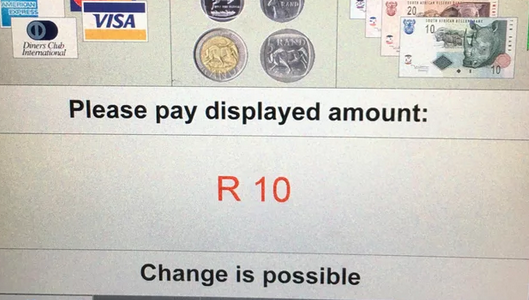I don’t know about you, but I personally struggle with finding sense in the contemporary world in the face of climate change, but also in general, in the face of the contemporary world.
I’m a scientist, a hydro-climatologist. I work with climate data. I read scientific papers. I know Clausius-Clapeyron equation. I know the planet is heating. I know rainfall is variable. I know about floods. I know Hadley cell expands. I know ice caps melt. I know about droughts. I know about climate models, and I trust them (to a certain extent, of course).
I’m also an environmentally conscious citizen, or so I think of myself. I avoid the source of all evil – plastic straws. I sort and recycle. I commute on a bike. I refuse plastic bags while shopping. I turn the tap off, and switch the light off too. I scale down on beef, and more and more frequently buy organic. I don’t leave trash behind. I commune with nature, appreciate flowers, birds, bugs, spiders and snakes, I take elements in a stride, I get cold when it’s cold, I get wet when it’s raining, I sweat when it’s hot.
Finally, I have some life experience. I grew up under communism. I lived in a first world country. I lived in rural Africa. I live in this weird dichotomous place where Africa meets the first world. I’ve been in touch with dialectical materialism. I’ve been on a receiving end of development aid. I’ve lived through entrenchment of neo-liberalism.
The point is: I know this climate change thing is real. I know it is hurting us, I know it will hurt us more. But I also know it’s not all gold that glitters. I know not everything is climate change. I know climate change is but one of many problems we, the world society, face, and it’s impacts are compounded by those other problems and often inseparable.
With all this, when I look at what’s happening around me, I’m not sure we have a plan on how to proceed. If we do – I cannot understand it, and I cannot really make sense of it. All this knowledge and experience has not equipped me to handle that problem. I’m not talking about me saving the world. I’m talking about gaining some understanding, so that I can be happy, content, and not worry much about future of my kids.
What is the way forward? For me, as an individual? For me as a scientist? For my family? For my kids? For my friends? For my research group? For my country? Who’s the enemy here? Government? The one percent? The poor? The Big Oil? What are we really fighting against? What are we really fighting for? Am I doing enough? Are we doing enough? Perhaps we should be doing something totally different? Is COP process the right way? Is Extinction Rebellion’s? SchoolStrike4Climate’s? Is it time for more radical approaches, “ecotage”, perhaps?
I don’t think I can get those answers, but I want to think of them taking into account the complexity of the world, the fact that a coin has two sides and that there are many shades of grey.
It’s a big task, exceeding the capacity of this medium (an for sure of this post). But let me try commit a few blogs to it. I’ll try to maintain the optimistic view – hence the title… Join me in this undertaking, if you will.
Let me start with global carbon emissions.
Rewind to the mid-1990s. This is the time series of global CO2 emissions by 1990, the projected emissions as per IPCC Second Assessment report IS92 scenarios that were generated about that time, and the actual trajectory we have followed between 1990 and now.
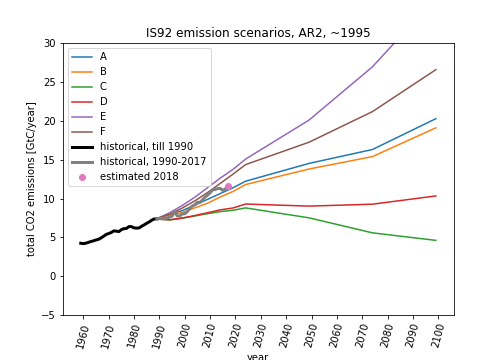
Forward to early 2000s. This figure is similar to the one above, but the projections are those of IPCC AR4 SRES scenarios.
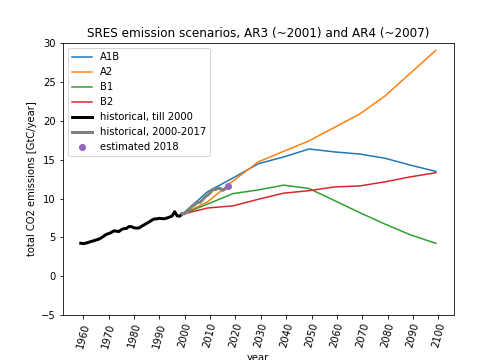
Forward another 10 years. Same as above, but with IPCC AR5 RCP scenarios.
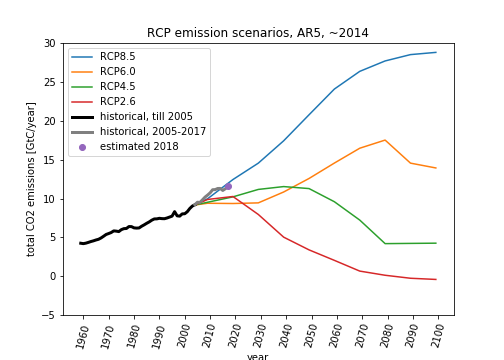
This is how I see the above: we do a range of projections of future carbon emissions. Those include projections that are, from impact point of view, optimistic, less optimistic and, well… pessimistic. Then, in spite of the warning, we follow up the most pessimistic one.
What are those pessimistic projections? The one we are following describe world with “very rapid economic growth (SRES A1)”, “regionally oriented economic growth (SRES A2)” and a world with “no policy changes to reduce emissions and heavy reliance on fossil fuels (RCP 8.5)”.
The ones we hope we would follow, but we don’t, are for the world of “rapid changes in economic structures toward a service and information economy, with reductions in material intensity, and the introduction of clean and resource-efficient technologies (SRES B1)”, or “local solutions to economic, social, and environmental sustainability (SRES B2)”, or “relatively ambitious emissions reductions (RCP 4.5)”, or “ambitious emission reductions (RCP 2.6)”. Would be nice to get one of those, but alas! We keep scooting along a dangerous path like it was a stroll in a park.
Yes, but we are getting there, aren’t we? You know… Kyoto protocol, Cancun amendment, Paris agreement? Don’t those help? OK, another figure.
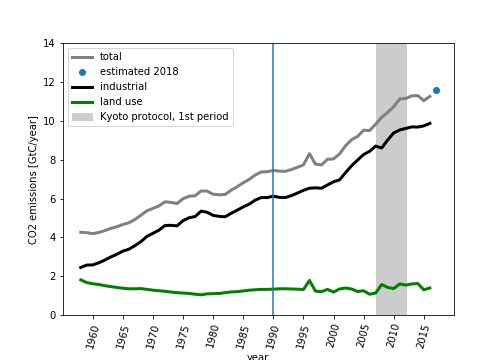
This one shows the historical emissions, split into industrial and land use-related. The blue vertical line marks 1990. The band – the period when Kyoto protocol was in place, i.e. 2008-2012. The goals of Kyoto were to see participants collectively reducing emissions of greenhouse gases by 5.2% below the emission levels of 1990 by 2012. What we have, however, is an overall increase of emissions by 50% between 1990 and 2012. Target for the post 2012 period was even more ambitious. But it was never really binding, as the negotiations to implement it collapsed. Paris agreement was born from the Kyoto’s ashes.
So, however successful we make in on paper, as the above figure shows, from the purely utilitarian perspective, Kyoto protocol was not particularly successful, was it?
Were we even trying?
There is a zillion of caveats to the Kyoto protocol, that determine what counts, what does not (the protocol did not include emissions from shipping and air transport, for example), different rules for different countries (industrialized and not yet industrialized) countries, plus a multitude of individually-negotiated deals) and the messy mess of carbon trading to top it up.
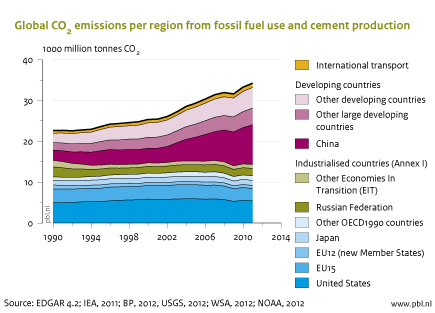
The above figure shows that we were trying. Not very strongly, but at least a little. Basically, industrialized countries reduced emissions (or whatever they counted as such), but the so-called developing countries did not. But they were not expected to, and it is a story for another blog.
A thing that helped to balance the final outcomes of the Kyoto protocol, at least for Europe, is the early 1990s decline of emissions from the so-called Economies in Transition, or post-communist countries, whose economy basically collapsed at the fall of the Eastern bloc. The 2008 global economic crisis helped too. Also, one should think, globalization – the progressive liberalization of international trade, again related to the fall of communism and the change in the economic paradigms in China. What it likely caused is that at least some part of the reduction in emissions visible in the figure above for the US and EU is due to “offshoring”, i.e. replacement of explicit emissions due to manufacturing consumer goods locally with “latent” emissions present in products imported from cheap labour countries. As a result, the growth of emissions in case of China is not only due to China development, but also includes some of the emissions that were shed by EU and US…
At this stage, one should introduce and unpack a couple of terms: consumption- and production-based emissions and decoupling. But let’s talk about these some other time. For the time being, let the bits of information presented above sink in, and make us think.
Data sources:
Projections: https://www.ipcc-data.org/sim/index.html
Historical emissions: https://www.earth-syst-sci-data.net/10/2141/2018/
By country emissions figure: https://www.pbl.nl/en/publications/2012/trends-in-global-co2-emissions-2012-report
Title figure: just a random snap from Google Image search…
